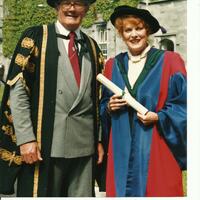 Maureen O'Hara Blair, DLitt honoris causa, 1988
Maureen O'Hara Blair, DLitt honoris causa, 1988 Maureen O'Hara Blair with Dr Colm Ó hEocha, President of UCG, following conferral by the NUI, on the proposal of UCG, of the honorary degree of DLitt on her in UCG on June 26, 1988. The citation was given by Dr Ó hEocha, who here is wearing the robe appropriate to his office as one of the three Pro-Vice-Chancellors of the NUI.
In an interview on that occasion with Jim Fahy of RTÉ, Maureen said, 'This particular honour here - I have won many, many awards all over the world, I have been honoured in Spain, in Mexico, in Australia, in Cuba, but never in Ireland, and so it's really a great, great thrill to be honoured by this country that I was born in, and particularly by Galway, where we made The Quiet Man'. The photograph was taken in the Quadrangle.
Brian J. Donnelly, of Boston, Mass., USA former member of the US Congress (1979-93) being congratulated by An tOllamh Gearóid Ó Tuathaigh, who had delivered the citation, following the conferral by the NUI, on the proposal of UCG, of the honorary degree of LLD on him in UCG in June 1993. The photograph was taken behind the southwest corner of the Quadrangle.
Brian Donnelly was largely responsible for the enactment of the so-called 'Donnelly Visa' programme, which authorised 5,000 visas annually for citizens of countries historically under-represented in the United States' immigration system, and whose primary beneficiaries were, as was intended, Irish nationals.
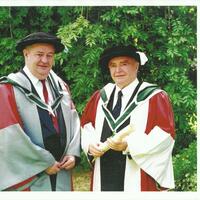 Heinrich Pfeiffer, DLitt honoris causa, 1993
Heinrich Pfeiffer, DLitt honoris causa, 1993 On the right, Heinrich Pfeiffer, Secretary-General of the Alexander Humboldt Foundation (1956-94) following conferral on him by the NUI, on the proposal of UCG, of the honorary degree of DLitt in UCG in June 1993, with Professor Matthew F. McCarthy, Registrar and Deputy-President, UCG, who delivered the citation.
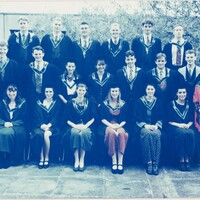 Biotechnology Graduate Class of 1995
Biotechnology Graduate Class of 1995 The B.Sc. in Biotechnology was planned from 1988 by a group convened by Prof. Denis Headon of the Biochemistry Department, with major input from Prof. Frank Gannon of the Microbiology Department. The first intake was in Sept. 1991. Dr Pat Morgan was appointed as Lecturer for this programme in Jan. 1992 and she assumed the role of Director in 1996.
A picture of the Biotechnology Graduation Class of 1995 is shown and class names are given from left to right below:
Top Row: Michael Considine; Christian Stafford; Eric Mortimer; John Lennon; Daniel McKenna; Turlough Rafftery
Middle Row: Padraig Kelliher; David Ryan; Bridget Jennings; Caren Coonan; Liam Duggan; Barry Glynn; Nigel Mongan; Dr Pat Morgan
Front Row: Elaine O’Doherty; Lassarina McLoughlin; Louise Kelly; Angela Stakelum; Michele O’Rourke; Aideen O’Doherty
The first intake of students for the new Biotechnology course took place in Sept. 1991 and attracted students from the counties of Clare, Galway, Laois, Leitrim, Longford, Mayo, Tipperary, Westmeath and Kerry.
The Biotechnology curriculum was novel at the time as it included Business modules as well as French or German and a research or industrial placement in the Summer of year 3. The knowledge of languages was a tremendous asset for students undertaking their 3rd year placements in Europe or later for their PhD o postgraduate research. The calibre of the students was outstanding and such was the reputation garnered over the years that B.Sc. graduates were sought after for research degrees in Cambridge, Oxford, European Molecular Biology Laboratory, Heidelberg. This first class, and many that followed, had a great esprit de corps and have maintained contact with each other and the University through various reunions.
Dr Pat Morgan was elected as Dean of the College of Science for the period 1998-2004 and was the first woman to hold the post since the establishment of the University. She was elected by academic staff to the Governing Authority of the University on six occasions, from 1998-2018 and to the Senate of the National University of Ireland from 2002-2022. She was appointed as the first Dean of Graduate Studies in 2008 and served in the post until her appointment as Vice-President for the Student Experience in 2011. She retired in 2018 and her portrait by Una Sealy RHA, hangs in Áras na Mac Léinn
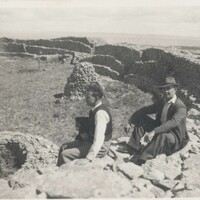 Inishmaan stone fort, 1948
Inishmaan stone fort, 1948 The photograph shows Patt Larkin, Prof. of Education, UCG (on the left of picture) with Mr. McGinley, a kelp inspector, on Dún Conor (Dún Chonchúir) on Inishmaan, Aran Islands. Dún Conor (Wikipedia_Conor, 2023) is a stone ringfort with partly rebuilt (by the OPW (Office of Public Works) ‘clocháns’ or stone houses. The three-stage, dry-built rampart is probably pre-Christian in foundation.
The kelp industry was important to the subsistence economy in the Aran Islands. Images of large piles of seaweed drying, prior to its burning for the iodine industry, are shown in the Chambers Archive, held by Galway County Council (Galway County Council Archives, 1929-1938); (J. Higgins,1931, pp 59 – 72). The seaweed was collected from rocks after the storms of autumn and winter, dried on fine days, and then made up into a rick, where it was left until the beginning of June. It is then burnt in low kilns on the shore, a process that takes from twelve to twenty-four hours of continuous hard work. The kiln holds about two tons of molten kelp, and when full it is loosely covered with stones and left to cool. In a few days the substance is as hard as the limestone and has to be broken with crowbars before it can be placed in curraghs for transport to Kilronan, where it is tested to determine the amount of iodine it contains and paid for accordingly. In former years good kelp would bring seven pounds a ton, now four pounds are not always reached (J. Higgins,1931, pp 59 – 72). The income gleaned from its collection, burning, sale and transport was significant for the Islanders (D. Fitzpatrick, 2012). In former years, good kelp would bring seven pounds a ton, now four pounds are not always reached (J. M. Synge,1907, pp 194-5).
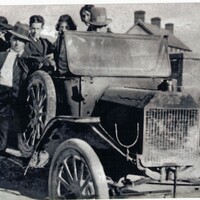 Motor vehicle on Beggars Bridge, 1921
Motor vehicle on Beggars Bridge, 1921 The picture shows (l to r) the following persons: Charlotte Carlos; vehicle driver; Patt Larkin; Rita Carlos; Nina Carlos; and Charles Carlos in / alongside a Model T Ford motorcar. The vehicle was located on Beggars Bridge (as written on the back of the photograph) at the UCG Rowing club. The Model T Ford motorcar was complete with removable acetylene lamps and was hired from Flaherty Motors.
Charlotte Shortle Carlos and Charles Carlos were the parents of Margaret (Rita), and Mary Josephine (Nina).
Rita married Patt Larkin, Prof. of Education, UCG and Nina married Tom Dinan, Prof. of Natural History, UCG.
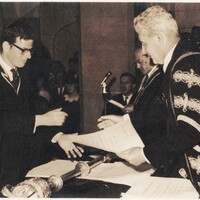 Patrick Larkin Graduation, 1966
Patrick Larkin Graduation, 1966 The photograph shows Patrick Larkin receiving the B.Sc. degree from Dr Martin Newell, President of UCG. Prof. Cilian Ó Brolcháin to the right of President Newell, was acting in his capacity as Dean of the Faculty of Science.
Martin J. Newell, was Professor of Mathematics in University College Galway (1955 -1960) and he was appointed President of University College Galway in 1960 and he retired from the post in 1975.
Cilian Ó Bhrolcháin, was appointed Professor of Experimental Physics in 1934 and he resigned from the post in 1973 (Tom O’Connor, 'Natural Philosophy / Physics’).
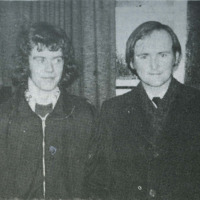 Eamon Gilmore and Harry Walsh President of UCG Students Union election 1974
Eamon Gilmore and Harry Walsh President of UCG Students Union election 1974 The victor of the 1974 election for President of UCG Students Union, Eamon Gilmore, is pictured with his opponent in the election, Harry Walsh. The election took place on 12th March 1974. 1,395 students voted in the election and Mr. Gilmore received 1,152 votes, representing 82% of the votes cast.
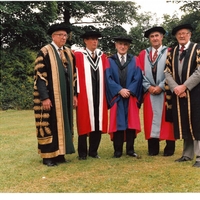 John McGahern, DLitt, Patrick D. (Paddy) Ryan, LLD, and
Patrick J. Leonard, DSc honorary conferrings, 1994
John McGahern, DLitt, Patrick D. (Paddy) Ryan, LLD, and
Patrick J. Leonard, DSc honorary conferrings, 1994 Image taken following the conferring in Galway of honorary degrees by the NUI, on the proposal of UCG, on John McGahern (DLitt), Patrick D. (Paddy) Ryan (LLD) and Patrick J. Leonard (DSc) in 1994. Image also includes Dr T.K. Whitaker (Chancellor of the NUI) and Dr Colm Ó hEocha (President of UCG).
 Miss College Week 1974 Winner
Miss College Week 1974 Winner UCG student Sue Toner was the winner of the Miss College Week Competition 1974. This image appeared on the front cover of UNITY Magazine, a college publication produced by the UCG Students Union. The image was on the front cover of the magazine dated 14 March 1974.
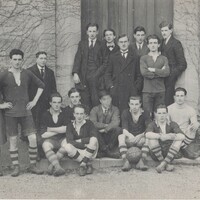 Gaelic Football, UCG in 1920
Gaelic Football, UCG in 1920 The picture shows seventeen men, all young with the possible exception of one person. Seven of the group are wearing football socks and one has a football balanced between his legs, with the inscription ‘UCG-1920-‘. One person appears to be holding a hurling stick. Some of the persons are semi-formally dressed with ties or bow ties.
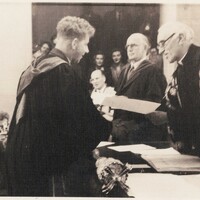 Kevin Larkin, Graduation in 1955
Kevin Larkin, Graduation in 1955 The picture shows Kevin Larkin receiving the B.E. degree parchment from the President of University College Galway (UCG), Revd Monsignor (Msgr.) Pádraig de Brún, M.A., D.Sc. The Registrar of the National University of Ireland, Séamus Wilmot is alongside the President. Patt Larkin, Prof. of Education can be seen to the left of the picture, taking a picture of his son Kevin. The University’s mace can be seen on the table.
Revd Msgr. Pádraig de Brún was formerly Professor of Mathematics at the University of Maynooth. He succeeded Msgr. John Hynes as President of UCG in April 1945 and he retired in 1959, due to illness. He passed away on 5 June 1960. Additional information of his life and career is presented by Lawrence William White in the Dictionary of Irish Biography (www.dib.ie/biography/de-brun).
Séamus Wilmot, a native of Listowel, Co. Kerry, B.A., B.Comm., H. Dip. in Ed., L.L.D. (jure officii), was appointed Registrar of the National University of Ireland, by the Senate, on December 11th, 1952. He retired on May 4th, 1972. He died on January 1st, 1977 (www.nui.ie/about/registrar).
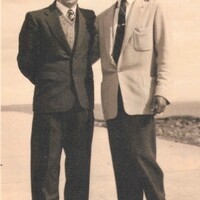 Frank Imbusch and Ephraim Idusogie, II
Frank Imbusch and Ephraim Idusogie, II Frank Imbusch is pictured with student Ephraim Idusogie in the late 1950s. Ephraim Idusogie was the son Chief Iyoha of the ancient city of Benin in Nigeria. The image was taken by an unidentified colleague of Frank Imbusch sometime in the late 1950s when Idusogie was a student at UCG. He spent two years at UCG (1956-57 and 1957-58) and transferred to UCC where he graduated with a B.Sc. degree in 1960. He subsequently returned to Nigeria to take up a teaching position.
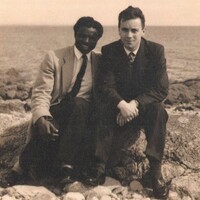 Frank Imbusch and Ephraim Idusogie
Frank Imbusch and Ephraim Idusogie Frank Imbusch is pictured with student Ephraim Idusogie in the late 1950s. Ephraim Idusogie was the son Chief Iyoha of the ancient city of Benin in Nigeria. The image was taken by an unidentified colleague of Frank Imbusch sometime in the late 1950s when Idusogie was a student at UCG. He spent two years at UCG (1956-57 and 1957-58) and transferred to UCC where he graduated with a B.Sc. degree in 1960. He subsequently returned to Nigeria to take up a teaching position.
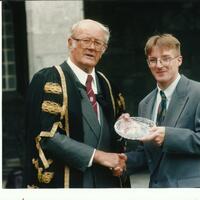 Jamesie O'Connor, Clare hurler, honoured by President Colm Ó hEocha following Autumn 1995 Degree Conferring ceremony
Jamesie O'Connor, Clare hurler, honoured by President Colm Ó hEocha following Autumn 1995 Degree Conferring ceremony Dr Colm Ó hEocha, President of UCG but here wearing his robe as a Pro-Vice-Chancellor of the NUI following the degree conferring ceremony on September 20, 1995, congratulating Clare hurler and recent graduate Jamesie O'Connor, BComm (1993), HDipEd (1994), to whom he had presented this Galway crystal plate during the ceremony, to mark the historic achievement of the Clare hurling team in winning the All-Ireland hurling championship on September 3, 1995 for the first time since 1914. The plate contained the arms of the College and of Co. Clare, with the inscription, 'Do Jamesie O'Connor, i gcuimhne ar bhua stairiúil Iománaithe an Chláir, Meán Fómhair 1995'.
In his Conferring speech, the President referred to the many connections between the College and Co. Clare, including the fact that, under the College's Charter, Clare had a representative on the Governing Body, that
6% of its enrolment, more than from any other County except Galway and Mayo, was drawn from Clare, that it had provided over the previous 25 years a range of Extramural Diploma courses in all towns of Clare, and that it had recently entered into an agreement with Shannon College of Hotel Management for the joint provision of a BComm degree course to students at Shannon College, the first graduates of which would, having spent the final year of their programme at UCG, be conferred at the following day's ceremony. Accordingly, he said, that in this milestone year of its own, it was appropriate for the College to honour its neighbouring County's historic achievement, one of the main architects of which was our own recent graduate.
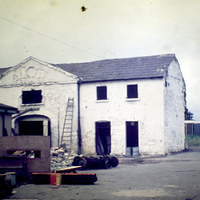 Belmount Building
Belmount Building The picture shows a large two-storey building with an upper triangular façade having what looks like crest-like or embellished features –characteristic of an estate type structure of old. Belmount demesne, including Belmount House. was purchased on behalf of the Commissioners of Public Works on 21 May 1846, for the erection of a new Provincial College, named Queens College Galway (Mitchell, J., ‘Queen’s College Galway, 1845-1858, pp 49 – 89').
The proprietor prior to the purchase of Belmount demesne was W. Whaley, Ormond Quay, Dublin according to John O’Donovan’s Field Name Books (Special Collections, University of Galway Library). The owner is alluded to as John Whaley (Mitchell, J., ‘Queen’s College Galway, 1845-1858', pp 49 – 89'). The holding of acreage (Irish) 14 A 2R 28P was sold for £3,469 9s 0d on 21 May 1846.
‘A dwelling house (Belmount House), situate on the grounds, has been converted, at a small expense, into an Anatomical School’ (Mitchell, J., ‘Queen’s College Galway, 1845-1858, p. 81'), and confirmed by Bill Noone, now retired and formerly worked in the Building’s Office.
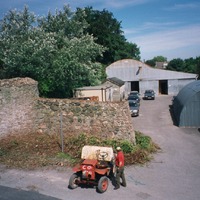 Buildings Office Complex
Buildings Office Complex A main feature of the photograph is a circular stone-like structure, which is likely to be a dovecote – a circular feature appears in the map of Belmount Demesne (Mitchell, J., ‘Queen’s College Galway, 1845-1858’). A wall is attached to the circular structure. An assortment of buildings, comprising one with a galvanised roof; a Nissen hut, a wooden shed and pre-fabricated shed – used by personnel of the Buildings Office are also visible. A probable Buildings Office employee alongside a small motorised transportation truck can also be seen.
Its location is at the North West of the University of Galway Library façade and North East of the Arts Millenium Building, and is now a parking area.
A dovecote is a structure intended to house pigeons or doves (https://slate.com/human-interest/2015).
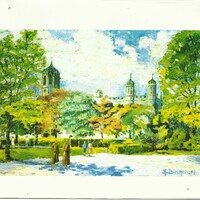 Dr Heinrich Becker Painting, 'Coláiste na hOllscoile, Gaillimh', 1941
Dr Heinrich Becker Painting, 'Coláiste na hOllscoile, Gaillimh', 1941 Painting by Dr Heinrich Becker (1907-2001), whose signature appears bottom right with the figure 41, of the Clock Tower and part of the upper northeastern wing of the Quadrangle of UCG visible behind several trees, with eight figures in the foreground, six of them walking, including two men in the brown clerical garb worn by Franciscan seminarian students, two women, and a man and another figure near the terrace, and a man and a woman standing on the tennis court at left. The scene is painted from the vantage point of the Old Arts building.
The painting was donated by the artist to the University in the 1990s and was included in an exhibition of 150 pieces of his painting, graphic and photographic work, 'Dúchas an Iarthair / Das Erbe des Westens' in the University's Art Gallery in October 1995 during the Comhdháil Litríocht agus Cultúr na Gaeilge organised by Roinn na Gaeilge, 13-14 Deireadh Fómhair 1995. Dr Becker came to Ireland at the suggestion of the folklorist Séamus Delargy and spent 7 months in UCG learning Irish and teaching German before beginning collecting marine and other folklore. He remained in Galway till 1941, the time of this painting, but later visited frequently, collecting Aran Islands (especially Inis Oírr) folklore in particular. He bequeathed his Collection to the University in 2001: it consists of research work, including fieldwork transcriptions, photographs and audio material and material relating to his publications. The material is divided up between Irish folklore, German folklore, and personal material.
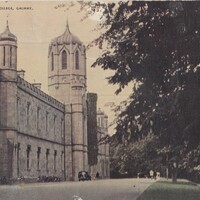 University Postcards
University Postcards The University Quadrangle Building, built in local limestone in a Tudor Gothic architectural style, is modelled on Christ Church at the University of Oxford (www.universityofgalway.ie). The Quadrangle Building, as well as the Aula Maxima, Laboratories, and other University scenes have formed the subject matter of postcards over the years. Two examples are shown here. The first is a classical picture of the Quadrangle Building with Clock Tower and two front corner turrets while the second picture shows an ivy covered Quadrangle façade with its clock tower, a turret and a steeple.
The first and earlier postcard was printed by Valentine & Sons Ltd., a Scottish printing company. As well as the Clock Tower, turrets at the two front corners of the Quadrangle Building are visible. The picture also shows a black motor car near the archway entrance with some people in the surrounds. As well as the towering trees and branches, a strip of green grass can be seen on the right-hand side – now used as a car park area.
The second postcard used a photograph taken by Patsy Clancy (Patsy Nic Fhlanncha), formerly Assistant to the Director at the Language Laboratory and Audio Visual Services (Saotharlann na Teanglainne agus Seirbhís na nAcraí Teagaisc) in the University. The concept is credited to Nuala Lardner, of the University Bookshop.
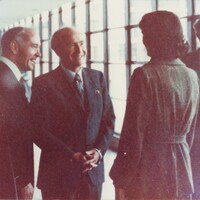 International Congress of Celtic Studies, 1979
International Congress of Celtic Studies, 1979 The Sixth International Congress of Celtic Studies was held at University College Galway from the 6th – 13th July 1979. Picture 1 shows the President of Ireland, Patrick Hillery in attendance (2nd from the left) alongside Prof. Gearóid Mac Eoin, and the President of University College Galway, Dr Colm Ó hEocha to the right of picture. The lady in the picture is unidentified.
Picture 2 shows President Hillery (centre) with Prof. Gearóid Mac Eoin (on the left) and Dr. Colm Ó hEocha, University President on the right of picture.
Picture 3 shows a special Conferring of Honorary Degrees by the National University of Ireland (N.U.I.) in UCG during the International Celtic Congress (NUACHT, 1979). Names are given below from left to right:
Top row: Prof. Antonio Tovar (Madrid); Somhairle Mac Ille Eathain (Scottish Gaelic Poet); Prof. P. M. Duval (College de France)
Front row: Prof. James Carney (An Institúid Árd Léinn); Dr. T.K. Whitaker (Chancellor, N.U. I.); Prof. Gordon Quin (TCD)
Born in Spanish Point, County Clare, Patrick Hillery qualified in medicine at UCD and following in his fathers’ footsteps, he practised as a doctor. He was elected to Dáil Éireann in 1951. He was a Government Minister from 1959 to 1973 and then became a European Commissioner up to 1976. Patrick Hillery was President of Ireland from 3 December 1976 to 2 December 1990 (Wikipedia, International Congress of Celtic Studies, 1979).
Dr Colm Ó hEocha was President of University College Galway from 1975 to 1996.
Gearóid Mac Eoin, M.A., D. Phil., was Ollamh le Sean agus Meán-Ghaeilge agus Teangeolaíocht Cheilteach from 1966 up to his retirement in 1994.
Galway was the venue of the Sixth International Congress of Celtic Studies, following the inaugural venue in Dublin, 1959, followed by Cardiff, Edinburgh, Rennes and Penzance, (celticstudiescongress, 2023). The Proceedings of the Congress were published in 1983 (Proceedings of the sixth International Congress of Celtic Studies, 1983).
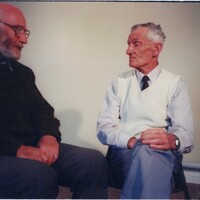 Nioclás Tóibín in Ollscoil na Gaillimhe
Nioclás Tóibín in Ollscoil na Gaillimhe Ba amhránaí ar an sean-nós é Nioclás Tóibín agus meastar go raibh tuairim is trí chéad amhráin aige idir Ghaeilge agus Bhéarla. Thug sé cuairt ar Ollscoil na Gaillimhe, áit ar chas sé le daoine as Roinn na Nua-Ghaeilge. Feictear é sa bpictiúir (ar thaobhn na láimhe deise) le Breandán Ó Madagáin, Ollamh le Nua-Ghaeilge.
Rugadh Nioclás Tóibín i mBaile Uí Raghallaigh, an Rinn, Co. Phort Lairge ar an 5 Feabhra 1928. Go hóg ina shaol b’éigean dó dul ar imirce go Sasana agus níor fhill sé ar an Rinn go dtí tuairim 1960. Chaith sé an chuid eile dá shaol ag amhránaíocht, idir chraoltaí raidió agus teilifíse agus choirmeacha ceoil. Meastar go raibh tuairim trí chéad amhrán aige idir Ghaeilge agus Bhéarla. Bhí sé in ann an veidhlín agus gléasanna eile ceoil a sheinm. Bhuaigh sé Corn Cuimhneacháin Sheáin Uí Riada sa chomórtas amhránaíochta ar an sean-nós trí bliana as a chéile (1961-63), éacht nach ndearnadh ó shin. Níor phós sé. D’éag sé ar 19 Meán Fómhair 1994 (www.ainm.ie/Bio).
Breandán Ó Madagáin, Ph.D., M.R.I.A., was Ollamh le Nua-Ghaeilge at Ollscoil na Gaillimhe.
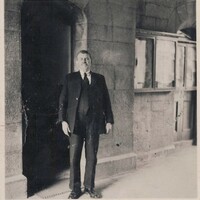 Porter, Paddy Higgins
Porter, Paddy Higgins The picture shows Paddy (Pat) Higgins, the Porter at University College Galway. He lived in the Archway of the University’s quadrangle building and he preceded Pádraig Ó Fátharta, who was Porter from 1958. The Porter was the custodian of the keys of the College and was likely first point of contact for those coming into the College, be they students, academics or visitors (Uí Chionna, pp 212 & 234, 2019).
In the words of Tom O’Connor who was interviewed by Jackie Uí Chionna for ‘An Oral History of University College Galway, 1930 – 1980’ (Uí Chionna, p. 212, 2019), “he (Pat Higgins) had a great dislike of people leaving their bicycles in the Archway. And he had this great skill of taking a bicycle and just flinging it out of the Archway, and you would be coming in and you would suddenly see this riderless bicycle come out of the Archway and across and down the steps”.
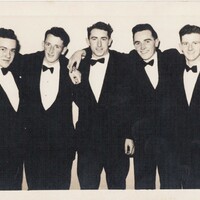 Grad Ball, 1956
Grad Ball, 1956 The photograph shows five men in dress suits and bow ties, at a Grad (Graduation) Ball dress dance. Their names are given below from left to right:
Séamus Harney; Johnny Donnellan; Packie Cummins; Frank Furey; and Pádraic Keane
The picture was taken by Stephen T. Cullum, Photography whose studio was located in Dominick Street, Galway (www.ouririshheritage).
Pádraic Keane was Lecturer in Anaesthesia at University College Galway (1970 -1989). He was appointed Critikon / Johnson & Johnson Professor of Anaesthesia in 1989 and he retired in 2001.
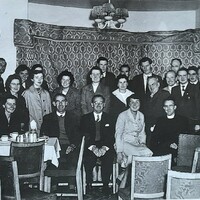 Odeon Café ~ 1964
Odeon Café ~ 1964 The picture shows a group of eleven women and sixteen men in the Odeon Café, Galway. The gathering includes Prof. Neil McDermott and Revd Fr Eustás Ó hÉideáin O.P., of University College Galway. Names of the Group are given in the 'People' Field below. The Odeon Café was located on William Street, Galway and became the Treasure Chest in about 1965.
The names of the people in the photograph are from left to right as follows:
Top row: Sean Ó Domhnaill (?); Noone (?); Tony Claffey; Unidentified; Mullaney (?); (?) Luddin; Donal Taheny; John Igoe; Paddy Brennan; Visiting American Academic [between the person in the 2nd row with glasses (Niall McDermott) and the person with Pioneer pin]; Sean Hawkins (?); and Eamon Duffy (with glasses)
Middle row: Joy McGloin; Eva McHugh; Elsie Igoe; Róisín Mullaney;Margaret Stewart; Una Keane; Prof. Neil McDermott; David Joyce; Bruce McDevitt; Fr. Dunne, C.S.S.R.
Bottom Row: Mrs. John Igoe; Larry Walsh; Eamon Lee; Mildred Reynolds,;Fr Eustás Ó hÉideáin O.P.; Nora Dorr (?)
Prof. Edward Neil McDermott was Professor of Therapeutics, Pharmacology and Materia Medica (1923-1972).
Revd Fr Eustás Ó hÉideáin, O.P. was Lecturer in Philosophy (1959-1968) and was Professor of Education (1968-1987).
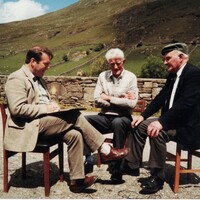 Corr na Móna Folklore Interview, 1989
Corr na Móna Folklore Interview, 1989 The picture shows Pádraig Ó Héalaí, on the left, interviewing local informants Pádraig Ó Caoidheáin, Dubhachta, Corr na Móna and Micheál Ó Caoidheáin, Dubhachta, Corr na Móna. A video recording of the interview was made by Seán Mac Íomhair and Patsy Clancy of the University’s Audio-Visual Unit and is now held in the Special Collections Folklore archive in the University Library.
Pádraig Ó Héalaí was Senior Lecturer le Nua-Ghaeilge (1981-2006) at the University of Galway.